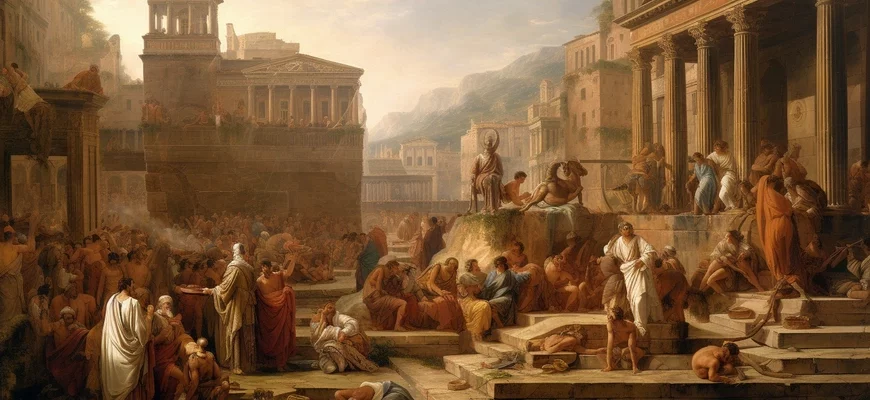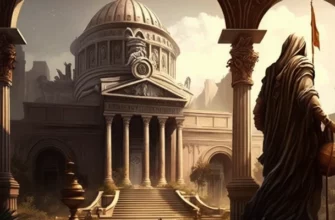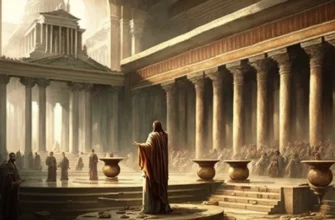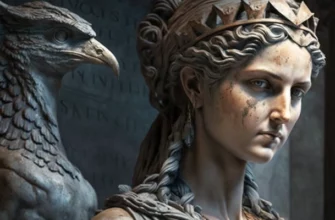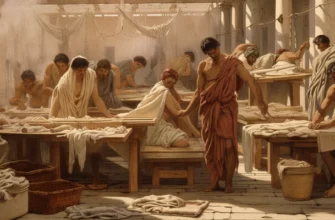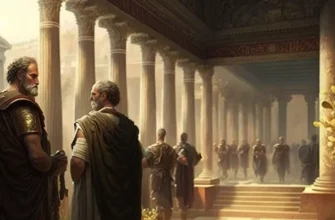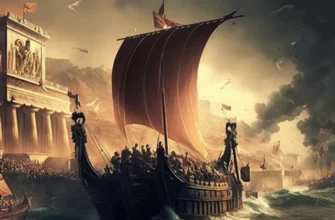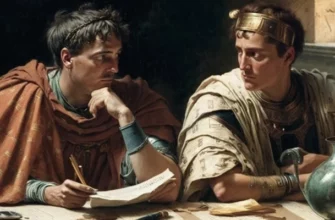Ancient Roman culture enriched the world on all levels, from architecture and art to literature and philosophy. Roman culture reflects a great empire that believed in its power and greatness. Its influence can still be felt in the modern world, as it created a great cultural heritage that is still being studied and researched today. Roman culture has influenced the development of many aspects of modern life, including architecture, art, literature, philosophy, religion, and cuisine. By learning about the history of this culture, we can better understand the world we live in today.
- Architecture of Rome
- Roman architecture: overview and features
- Notable architectural structures: Colosseum, Pantheon, Roman Forum
- The Art of Rome
- Roman art: main trends and styles
- Works by famous artists: Phidias, Polykleitos, Praxiteles
- Literature of Rome
- Roman literature: periods and genres
- Notable literary works: Virgil’s Aeneid, Ovid’s Satires and Metamorphoses
- Philosophy of Rome
- Roman philosophy: from Plato to Seneca
- The main philosophical schools: Stoicism, Epicureanism, Skepticism
- Religion in Rome
- Roman religion: gods and rituals
- The influence of religion on culture and everyday life
- Cuisine of Rome
- Roman cuisine: dishes and ingredients
- The influence of Roman culture on the modern world
- The cultural heritage of Rome in modern culture and art
- The influence of Roman culture on modern architecture and design
- Conclusions
Architecture of Rome
The architecture of Ancient Rome has left an unmatched legacy in the world of architecture. From amphitheaters, baths, and pools to temples, forums, and drainage systems, Roman architects created many buildings that remain symbols of grandeur and craftsmanship to this day. Roman engineers were masters at building over long distances and at great speed, which led to the creation of large roads and aqueducts that supplied the city with water. Roman architecture was a reflection of the power and wealth of the Roman Empire, which became a true treasure of world culture.
Roman architecture: overview and features
Roman architecture is considered one of the most outstanding in the world. Its features include huge amphitheaters, mastery in the creation of large roads and aqueducts, majestic temples and forums. Roman engineers were pioneers in the use of new technologies and materials such as concrete and stone. They were also known for the speed and precision of their construction, which allowed them to build tens of thousands of buildings in their cities. Roman architecture has become a true treasure of world culture and remains an inexhaustible source of inspiration for architects and researchers in the modern world.
Notable architectural structures: Colosseum, Pantheon, Roman Forum
The Colosseum, Pantheon, and Roman Forum are perfect examples of Roman architecture and engineering. The Colosseum is an amphitheater that could seat up to 80,000 spectators, the Pantheon is a temple with a powerful dome, which was one of the largest domes in the world at that time, and the Roman Forum is the center of the city where political, religious, and commercial events took place. All of these structures are of great historical and cultural significance and have become symbols of the Roman Empire. They continue to attract millions of tourists from around the world and remain a source of inspiration for many architects in the modern world.
The Art of Rome
The art of Ancient Rome was diverse and had much in common with Greek culture. Roman art reflected the history, religion, and everyday life of the Romans. Painting and mosaics were popular art forms, while sculpture was usually used to decorate buildings and monuments. Roman artists and sculptors were known for their skill and technique, using various materials such as bronze, marble, and terracotta. Huge Roman monuments such as the Colosseum, the Pantheon, and Trajan’s Column testify to the grandeur of Roman art and its influence on modern culture.
Roman art: main trends and styles
Roman art included various trends and styles that developed over a long period of time. One of the most famous styles is realism, which is characterized by an accurate reflection of reality, both in portraits and in scenes from everyday life. Another well-known style is classicism, which is based on Greek art and has a refined style and proportions. Baroque was also widespread, distinguished by its decorativeness and luxury. Roman art is also known for its mosaics, sculptures, and architecture, which remain an inexhaustible source of inspiration for contemporary artists and designers.
Works by famous artists: Phidias, Polykleitos, Praxiteles
Phidias, Polykleitos, and Praxiteles are famous artists of Ancient Rome. Phidias was a Greek sculptor who created such famous works as “Athena Parthenos” and “Zeus of Olympia.” Polykleitos was a Greek sculptor known for his work “Doryphoros,” which is one of the most famous depictions of the male body in Greek art. Praxiteles was a Greek sculptor who created the famous sculpture “Aphrodite of Knidos,” which is considered one of the most beautiful sculptures in the world. All three artists played an important role in the development of Greek sculpture and art in general, and their works have become eternal symbols of beauty and craftsmanship.
Literature of Rome
The literature of Ancient Rome has a rich history, including works by such famous authors as Virgil, Ovid, Cicero, Lucretius, and others. The works of these authors were written in the well-known languages of their time, such as Latin and Greek, and have become important sources of knowledge about the culture and history of Ancient Rome. The works of Roman authors cover a variety of topics, including poetry, prose, philosophy, and history. Their influence on world literature and art remains significant today.
Roman literature: periods and genres
The literature of Ancient Rome can be divided into several periods, such as Early Roman Literature, Republican Literature, and Imperial Literature. In each of these periods, different literary genres developed, including epic poetry, lyric poetry, drama, and prose. Early Roman literature consisted mainly of mythological and legendary tales, while Republican literature was marked by the development of the epic genre, particularly the works of Virgil and Cicero. Imperial literature was known for its philosophical and historical works, as well as satirical and love poetry. The literary heritage of Ancient Rome played an important role in shaping Western culture and literature and is recognized as a classic period of world literature.
Notable literary works: Virgil’s Aeneid, Ovid’s Satires and Metamorphoses
Among the outstanding literary works of Ancient Rome, it is worth mentioning Virgil’s Aeneid, an epic poem about the founding of Rome, Juvenal’s Satires, which satirize the vices of the society of their time, and Ovid’s Metamorphoses, a book of myths and legends about transformation. These works have become classics of literature and have survived to this day, helping us to understand the history and culture of Ancient Rome.
Philosophy of Rome
The philosophy of Ancient Rome is based on the Greek philosophical tradition, but has its own characteristics. Roman philosophers such as Cicero and Seneca sought to find answers to questions about morality, justice, and civic life. The philosophy of Ancient Rome was reflected in various works, including treatises and letters, which gave impetus to the development of European philosophical thought.
Roman philosophy: from Plato to Seneca
Roman philosophy began with Greek philosophy, particularly the ideas of Plato and Aristotle, which played an important role in shaping Roman culture. Ethical theories and legal philosophy developed in Rome, which became the basis for the work of Roman philosophers such as Cicero and Seneca. Roman philosophy was practical and aimed at achieving harmony in society, and its ideas became the basis for the formation of European philosophical thought.
The main philosophical schools: Stoicism, Epicureanism, Skepticism
There were several major philosophical schools in the Roman Empire, which differed in their ideas and approaches to life. Among them were Stoicism, Epicureanism, and Skepticism. Stoicism called for the rejection of external things and the search for inner harmony, Epicureanism focused on the satisfaction of the body and mind, and Skepticism rejected the possibility of knowledge and practical solutions, relying on intuition and chance. Each of these schools had an impact on Roman culture and became an important part of Roman philosophical thought.
Religion in Rome
Religion played an important role in the history of Ancient Rome. The Romans believed in polytheism, with Jupiter, Juno, Minerva, and Venus standing out among the main gods. Religious rituals, such as sacrifices and prayers, played an important role in the daily life of the Romans. There were also religious associations, such as colleges and imperial cult organizations, which preserved traditions and ensured the cultic cultural life of the city. Roman religion became an important factor in the formation of Roman culture and morality, and its influence is still felt in the modern world.
Roman religion: gods and rituals
Roman religion believed in the existence of many gods, the most important of which were Jupiter, Juno, Minerva, and Venus. Believers who sought support and protection from higher powers participated in religious rituals such as sacrifices and prayers. In addition, there were religious associations that provided cultural life in the city. Rome had many rituals related to religion, which were an important part of the lives of the city’s inhabitants. Roman religion had a great influence on the culture and morals of the people, and some of its aspects, such as Christmas, continue to exist today.
The influence of religion on culture and everyday life
Roman religion influenced many areas of life in Ancient Rome, including politics, social relations, art, and culture. Many religious holidays were celebrated as public holidays, which united different social groups and strengthened their ties. Religious rituals played an important role in everyday life, and religious institutions such as temples became a hallmark of Roman architecture. Religious art also had a significant influence on the development of art in Rome.
Cuisine of Rome
Ancient Rome had a rich culinary culture based on the use of meat, fish, vegetables, and spices. Dishes such as grilled meat, pasta, cheese, and wine were popular. Traditional dishes such as feeders and kebabs were often served at religious festivals. In addition, the Romans were known for their desserts, particularly honey cakes and fruit. Roman culinary culture became an important part of European culinary heritage, and many dishes we know today have their roots in Roman cuisine.
Roman cuisine: dishes and ingredients
Roman cuisine was diverse and used a wide variety of ingredients. The main ones were meat, fish, vegetables, fruit, and spices. Popular dishes included pizzas, various types of meat, egg dishes, and desserts such as honey and fruit cakes. Many dishes were cooked over a fire or open flame, and seasonings such as nuts, garlic, and pepper were used to give them a richer flavor.
The influence of Roman culture on the modern world
The culture of Ancient Rome has had a major influence on the modern world. Roman architecture has influenced the construction of buildings, and Roman art and literature have influenced the development of modern culture. The Roman legal system has influenced most of the legal systems of the modern world, and Roman medicine has influenced the development of modern medicine. Roman culture has also left its mark on modern cuisine, particularly in the use of spices and seasonings.
The cultural heritage of Rome in modern culture and art
The legacy of Roman culture is reflected in architecture, art, literature, and philosophy. The influence of Rome is evident in modern legal systems, language, cuisine, and architecture. The classical style and ideas of Roman culture are used in modern films, museums, music, and other art forms. The legacy of Rome is an inexhaustible source of inspiration for culture and art around the world.
The influence of Roman culture on modern architecture and design
Roman culture has left a significant mark on architecture and design, from architectural forms and details to the use of Roman motifs in modern interior design and decorative elements. Structures such as arches, columns, and domes are popular elements in buildings around the world. Roman motifs are also often used in the design of furniture, textiles, and other household items, demonstrating that Roman culture remains an inexhaustible source of inspiration for contemporary designers and architects.
Conclusions
In conclusion, it can be said that the culture of Ancient Rome is an important part of the world’s cultural heritage. Roman architecture, art, literature, and philosophy have had a great influence on the development of culture throughout history and continue to leave their mark on the modern world. Roman culture has influenced the architecture, design, and art of the modern world, and its legacy continues to live on in our culture and everyday life. Many of the ideas and values that originated in Ancient Rome are still relevant and important today, which is why studying this culture is so important.
